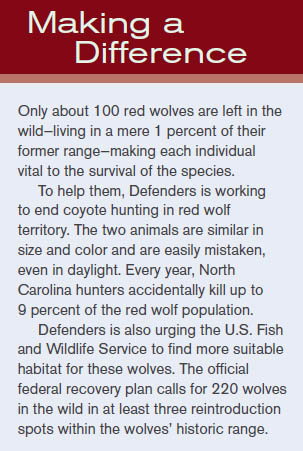Red Wolves

Despite their name, there’s only a dusting of cinnamon color atop their tawny or brownish and black coats. But Red Wolves are what they’ve been dubbed—even though most Americans don’t know they exist.
Many people are familiar with the iconic gray wolves and their return to the Northern Rockies. Far fewer know about this canid cousin in North Carolina, once commonly found amid the longleaf pine savannas and deciduous forests of the Southeast.

In fact, the Red Wolf was the first species to be saved from extinction in North America thanks to the capture and breeding of the last few in existence in the 1970s. Their offspring were later reintroduced into the wild. This last-ditch effort by the U.S. Fish and Wildlife Service paved the way for captive-breeding programs that have ensured—so far—that other highly endangered species, such as the black-footed ferret, California condor and Mexican gray wolf, remain with us today.
But as with all canids, Red Wolves are as polarizing as they are charismatic. These shy, elusive creatures remain misunderstood predators even though they still stand at extinction’s door. Threats include habitat loss and competition and interbreeding with coyotes, which moved in from the West after the wolf’s near-demise. Today, climate change is adding to the Red Wolf’s woes. The population’s current range is confined to eastern coastal areas of North Carolina that are only three feet above sea level.
It’s time we do something for these overlooked animals—before they literally go under.
—Heidi Ridgley
Only select articles from Defenders are available online. To receive 4 issues annually of the full award-winning magazine, become a member of Defenders of Wildlife!

